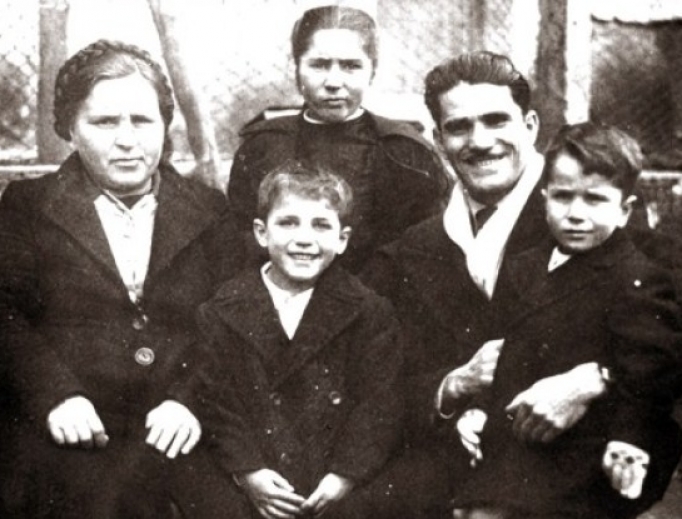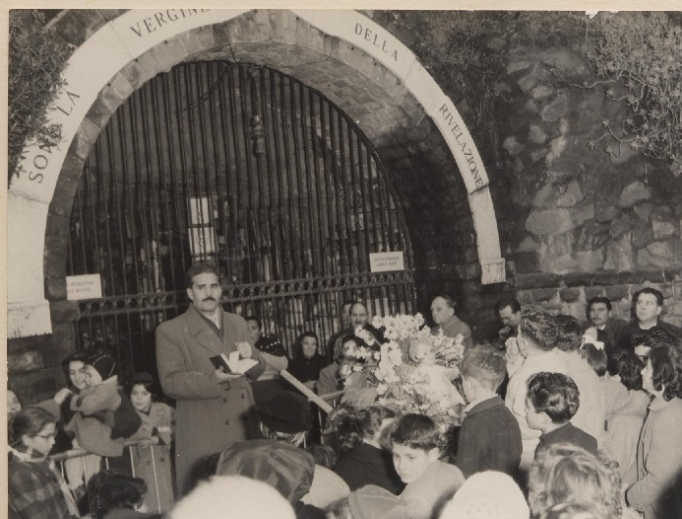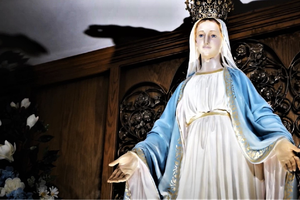From Contemplating Murder to Honoring Mary: The Marian Apparition at Tre Fontane
The Virgin of Revelation story reflects the power of good over evil.

The World War II debris lingered as Bruno Cornacchiola, an anti-clerical Protestant, had every intention to murder Pope Pius XII — until the Virgin Mary interfered April 12, 1947, at Tre Fontane (“Three Fountains”).
She called herself the “Virgin of Revelation.”
The Virgin of Revelation story reflects the power of good over evil and strength in the mask of weakness.
Cornacchiola was enjoying a day at the park with his three children. He was preparing a vulgar speech denying the Virgin Mary’s existence for his role in the local Seventh-day Adventist Protestant community.

When he realized his children’s voices were becoming faint and went to search for them, he found his children kneeling like marble statues in front of the grotto, repeating the words “Beautiful lady.”
Shortly after, Cornacchiola was able to see the Virgin, who was dressed in white, wearing a green mantle with a pink band, and holding the Scriptures.
“I am the Virgin of the Revelation. You are persecuting me — enough of it now!” she told him. “Enter into the sheepfold, the holy court of heaven on earth.”
Our Lady also gave a heavenly sign to Pope Pius XII through Cornacchiola, who was asking for confirmation on how to clearly define the dogma of the Assumption in light of his encyclical issued Nov. 1, 1950.
“My body could not decay and did not decay. My Son and the angels took me to heaven,” were the words from the Virgin given to Cornacchiola for the Holy Father.
He carried this message to the Vatican. During his audience with Pius, Cornacchiola asked for forgiveness for his hatred against the Catholic Church after his conversion to Protestantism. This is what led him to plot against killing the Pope. He confessed to Pius that he even bought a dagger with the inscription “death to the pope.”
Cornacchiola’s reconversion launched his entrance into the “sheepfold,” the Catholic Church. His conversion was lasting.
“This place is a place of great conversion, a call to the truth of the Catholic Church,” explained Mother Rebecca Nazzaro, mother superior of the Missionaries of Divine Revelation, a religious order inspired by the message of the Virgin.
This year marks the 71st anniversary of this Marian apparition. The grotto is neighbored by the Tre Fontane Trappist Abbey, just south of Rome, and is presumed to be the place where St. Paul was martyred.
Each year, the Franciscan caretakers of the grotto, the Order of Friars Minor Conventual, organize the anniversary celebrations of the apparition. These celebrations are attended by thousands of devotees of the Virgin of Revelation, the family of Bruno Cornacchiola and the Missionaries of Divine Revelation.
“He was neither soft nor sweet, as we may picture a visionary to be,” recalled Mother Rebecca of the recipient of the apparition, describing his strong-willed character. “On the contrary, he was a true St. Paul, so he was very incisive and strong when he spoke. However, this strength derived by the truth of faith that helped many people return to the Catholic Church.”
Cornacchiola evangelized for the Church until his death in 2001. His two sons continue to tell his story.
In a local Italian TV interview the morning after the celebration, April 13, Carlo Cornacchiola, who was 7 years old at the time of the apparition, expresses his greatest takeaway: “I felt a choice of responsibility. It changed our life, not only our father’s.”
The simple grotto at Tre Fontane has become a place of prophecy.
“St. John Paul II named the site ‘St. Mary of the Third Millennium at the Three Fountains.’ This is a prophecy — who knows when it will come true? But the Virgin requested [to Cornacchiola] to have a big sanctuary built here,” Mother Rebecca said.
Several stages have been taken toward planning a new sanctuary, since the Diocese of Rome bought the ground on which the grotto is located.
At the shrine, two Masses are said each weekday, with five Masses every Sunday. Pilgrims from all over the world come to receive the graces that have been proven to be granted there. The first miracle happened two months after the apparition to Carlo Mancuso, who fell from an elevator shaft and received countless injuries in his arm and pelvis. After contact with the soil from the grotto, he was able to walk again, despite the x-rays still showing fractures in his body.
The holy atmosphere is a stark contrast to which Tre Fontane was originally known.
“The grotto of Tre Fontane was a place of ‘sin’ because it was a place of illicit meetings and also where the remains of aborted children were found. Therefore, Our Lady said, ‘With this soil of sin, I will work great miracles for the conversion of unbelievers and sinners,’” explained Sister Emanuela Edwards, a Missionary of Divine Revelation.
Behind the grotto there is a small corridor with a collection of photos, flowers, mementos and a carved plaque, left in gratitude to the Virgin. Toward the end of the corridor is the heart of the grotto, which marks the exact place the Virgin Mary disappeared from Cornacchiola, turning in the same direction as St. Peter’s Basilica. The converted man prayed there often to ask for particular intercessions.

The Marian apparition at Tre Fontane was informally approved by Pope Pius XII on October 5, 1947, when he blessed the Virgin of Revelation statue with a procession from the Vatican to the grotto and gave permission for Cornacchiola to speak about the apparition. Steps toward official approval are underway but have not yet been completed.
The Missionaries of Divine Revelation dedicate their lives to spreading the message of the “three white loves” that the Virgin of Revelation revealed in her apparition: the Eucharist, the Immaculate Virgin Mary and the Holy Father.
They share this through the color of their habits and have become to be known as the “green nuns.”
“The Virgin meant something, even through these colors [that she wore in the apparition]. What did she want to explain? Her relationship with the Holy Trinity,” said Mother Rebecca. “Therefore, the Virgin Mary wants to express her precise relationship with the Holy Trinity also through the use of color.”
The Mother Superior continued to explain the significance of each color. Green is a symbol of creation, which stands for the Father, and the Virgin is the daughter of the Father. White symbolizes grace, and Mary is the Mother of the Son, Jesus. The Holy Spirit, as the Spouse of the Holy Spirit, is represented by the color pink.
The 15 sisters in the community focus on the formation of authentic Christian living through catechesis in the parish and in the family. They also share their message through their “Catechesis with Art” program, serving as official guides of St. Peter’s Basilica and the Vatican Museums.
“I bring the faith to the people through the art, not just the history,” Sister Emanuela said.
Sister Emanuela was a driven businesswoman based near Manchester, England, who found her vocation after a weekend trip to Rome with a friend. She visited the grotto, and from that moment, she had a sense that she was called to be like the “sisters in green.” She made her final profession on the anniversary of the apparition in 2015.
She emphasized of the grotto, “It is a special place.”
Rachel Lanz is the journalism intern for EWTN in Rome. She blogs at NCRegister.com.
Editor's Note: This story was updated after it was posted re: the process of approval for the apparition.
WATCH
- Keywords:
- marian apparitions
- rachel lanz
















